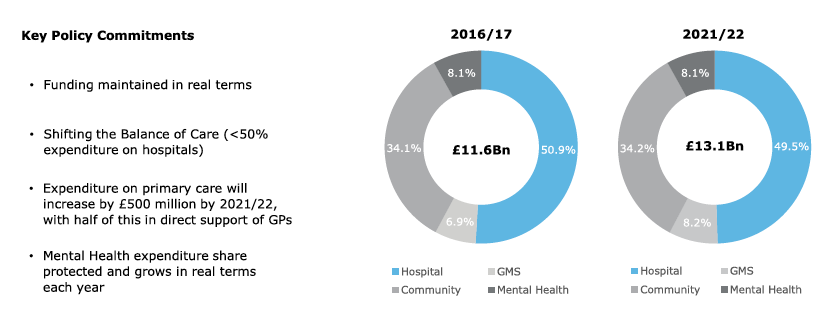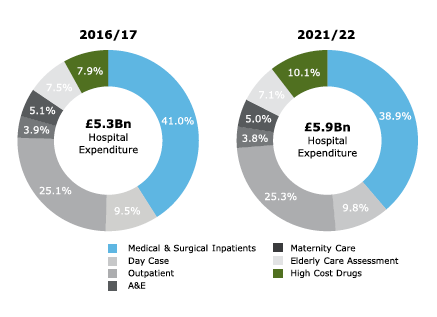Health and Social Care: medium term financial framework
This Framework supports the Health and Social Care Delivery Plan and sets out in more detail the potential approach and type of initiatives required to ensure continued delivery of a financially balanced and sustainable Health and Social Care system.
Future Shape of Health and Social Care Expenditure
Government Spending Policy Commitments
The Scottish Government has made a number of policy commitments to be delivered in this parliament in relation to health and social care expenditure, that will influence the future shape of the budget, as well as drive reform across the system. Over the medium to long term this will influence the setting in which care is delivered, as well as redirect resources to priority areas for expenditure. The financial implications of these commitments are important to understand and plan for over the next 5-7 years and beyond.
The focus of the financial framework is on the main health and social care expenditure commitments, as set out below:
- over the course of this parliament, baseline allocations to frontline Health Boards will be maintained in real terms, with additional funding over and above inflation being allocated to support the shift in the balance of care. This means that health expenditure will be protected from the impact of rising prices and will continue to grow in excess of GDP deflator projections;
- over the course of the next five years, hospital expenditure will account for less than 50% of frontline NHS expenditure. This relates to the policy commitment to ‘shift the balance of care’, with a greater proportion of care provided in a setting close to a person’s home rather than in a hospital;
- funding for primary care will increase to 11% of the frontline NHS budget by 2021/22.[12] This will amount to increased spending of £500 million, and about half of this growth will be invested directly into GP services. The remainder will be invested in primary care services provided in the community; and
- the share of the frontline NHS budget dedicated to mental health, and to primary, community, and social care will increase in every year of the parliament. For adults, and in some cases for children, these services, along with unscheduled hospital care, are now managed by Integration Authorities.
The analysis below considers how these commitments will influence the future shape of health expenditure through to 2021/22 and the associated implications for future funding growth.
Future Shape of the Frontline Health Budget
Modelling was undertaken to assess what existing baseline spending for frontline Boards may look like in 2021/22, taking into account the commitments outlined above. Figure 6 illustrates the results, comparing the current position with that projected in five years’ time. It illustrates that at present 50.9% of frontline health expenditure is allocated to the hospital sector, with 34.0% spent on community services, 8.1% on mental health[13] and 6.9% on GP services (funded directly by the General Medical Services contract).
In the future, it is estimated that the baseline budget for frontline Boards will be at least £1.5 billion higher at £13.1 billion. This reflects the impact of increased spending in line with inflation, supporting the shift in the balance of care, and providing additional support to improve waiting times. Within this overall position, the share of expenditure on hospital services will comprise less than half of frontline spending, with a corresponding increase in funding for community health services. In addition, there is expected to be further funding flowing from the commitment to pass on Barnett resource consequentials in full, and this will also be prioritised towards supporting the shift in the balance of care.
Figure 6. Future Shape of Frontline Health Expenditure

Figure 7 illustrates the main components of current hospital expenditure, with medical and surgical inpatient services accounting for the majority of expenditure (41%), followed by outpatient services (25%) and day case surgery (9.5%). In five years’ time the hospital budget would be larger, standing at £5.9 billion, but the composition of spend will likely be different.
Figure 7. Future Shape of Hospital Expenditure

Summary
The analysis illustrates how we plan to reshape expenditure patterns across the health and social care sector, with a gradual rebalancing of expenditure towards care delivery outwith a hospital setting. There is evidence that health and social care is being reformed and that there will be significant investment to support this over the next five years. We know ultimately that the outcomes in many circumstances are better, with fewer interventions, when care is delivered in a community setting. Health and Social Care Integration focuses on delivering care in the right place, at the right time, ensuring both the quality and sustainability of care.
Early evidence from Integration Authorities suggests that achieving this shift to primary and community care can be delivered, given the opportunities to deliver care in different settings and in different ways, however it will require appropriate investment in reform and a change in the way services are delivered across Scotland.
Through the Ministerial Strategic Group for Health and Community Care, partnerships have shared projections for their performance on the Delivery Plan objectives over the period to the end of 2018/19 and these show improvements in a number of areas. For example, for unplanned bed days, there is already an overall 7% reduction projected against the 2016/17 baseline, which is consistent with the Delivery Plan objective for a 10% reduction by end 2020. This includes a 16% reduction in days lost to delay.
Contact
Health Finance Team:
Health_Finance_Divisional_Support@gov.scot
There is a problem
Thanks for your feedback